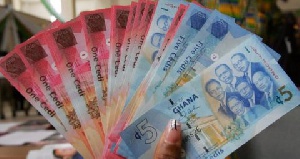 The cedi is trading at about 4.40 against the US dollar at the forex bureau
The cedi is trading at about 4.40 against the US dollar at the forex bureau
Ghana's local currency, the Ghana cedi ended the first quarter of this year with a depreciation rate of 2.52 per cent to the US dollar.
This is against a depreciation rate of 2.80 percent at the end of January 2017 and 6.2 per cent at the end of March 2017.
Many analysts are optimistic the local currency will do well against the American greenback following the approval of the 2017 budget and its implementation.
Additionally, the US$2.2 billion from the sale of long-dated domestic bonds on Friday, March 31, 2017 is expected to boost Bank of Ghana reserves and also buttress the cedi’s performance this year.
Among six African currencies that were captured by Frontline Capital Advisors, the local currency, the Nigerian naira, Egypt pounds and Kenyan shillings all registered depreciations against the American dollar. They declined in values by 2.52 percent, 1.99 percent, 0.11 percent and 0.56 percent respectively.
Mauritius rupees and Moroccan dirham however increased in value against the US dollar by 2.03 and 1.10 percent correspondingly.
The recent Monetary Policy Report indicated that the foreign exchange market witnessed increased pressures in the year to early March, partly attributed to a strengthening US dollar, seasonal demand factors and speculative activities.
However, the observed pressures have significantly eased in recent weeks on the back of renewed confidence in the economy and improved foreign exchange inflows.
Financial and market portal ‘Doobia’ said the recent stability in the cedi will continue, adding “we could see further appreciation in the second half of the year as we boost foreign exchange reserves from increased oil revenue and proceeds from COCOBOD syndication”.
Presently, the cedi is trading at about 4.40 against the US dollar at the forex bureau and 4.28 on the interbank market.
Meanwhile, Treasury bill rates have gone up slightly after being on a downward trend for some time. The 91-day and 182 day Treasury bill rates are presently hovering around 17.38 and 17.18 percent respectively.
From a one year horizon, yields across the yield curve have been on a downward decline albeit the recent northward movement on the shorter end of the yield curve as the government seeks to revive demand in its bills.
Commenting, investment bank, Frontline Capital Advisors said “We believe the recent 200 basis points decline in the monetary policy rate coupled with anticipated longer dated issuance and the improved outlook to inflation could be an important inflection point on the curve, providing the catalyst for the shorter end to revert to its downward trajectory.